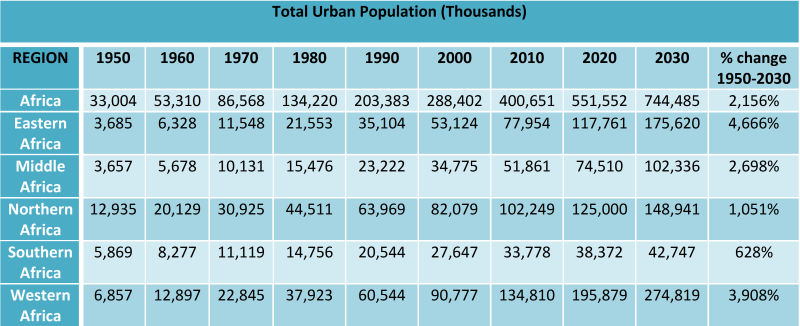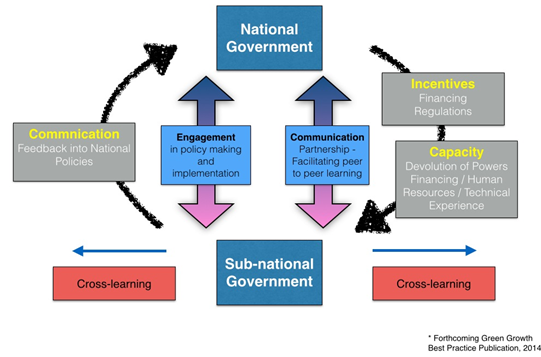Last month as part of the Green Growth Knowledge Platform (GGKP) and Africa Low Emissions Development Strategies (LEDS) Partnership meeting in Kinshasa, DRC, I had the pleasure to host a parallel session on Sub-national Governance and Climate. There are 2 interconnected trends in Africa—both related to speed—that provided the foundation for our discussions.
 The first trend concerns Africa experiencing the fastest rates of urbanization of the whole developing world, (even though it’s slightly lower than 10 years ago) (Urban Population Tables). The second trend is the fact that Africa’s economy is growing faster (5% in 2012) than the economies of all other continents—despite heightened tensions, uncertainty, and a contracting world economy (UN ECOSOC Overview, Africa 2012-2013). While much of the investment is in the agriculture and mineral sectors (Africa contains 60% of the world’s potential farmland), the economic growth is markedly “urban driven”—an outcome of increasing domestic demand, i.e. public spending on infrastructure, rising incomes, private consumption, increasing trade, etc. However, the rapid urbanization and economic growth trend in Africa is failing to generate inclusive growth nor improve environmental sustainability. Rather, the high degree of inequality and environmental degradation thwarts the impact of growth on poverty. Achievement of the Millennium Development Goals by 2015 is unlikely.
The first trend concerns Africa experiencing the fastest rates of urbanization of the whole developing world, (even though it’s slightly lower than 10 years ago) (Urban Population Tables). The second trend is the fact that Africa’s economy is growing faster (5% in 2012) than the economies of all other continents—despite heightened tensions, uncertainty, and a contracting world economy (UN ECOSOC Overview, Africa 2012-2013). While much of the investment is in the agriculture and mineral sectors (Africa contains 60% of the world’s potential farmland), the economic growth is markedly “urban driven”—an outcome of increasing domestic demand, i.e. public spending on infrastructure, rising incomes, private consumption, increasing trade, etc. However, the rapid urbanization and economic growth trend in Africa is failing to generate inclusive growth nor improve environmental sustainability. Rather, the high degree of inequality and environmental degradation thwarts the impact of growth on poverty. Achievement of the Millennium Development Goals by 2015 is unlikely.

Integrating Sub-national and National Governance
Participants in the parallel session included representatives of national and sub-national governments as well as NGOs and civil society organizations. The session began with some presentations (available here) including;
- An overview of the Working Group on Sub-National Integration of the LEDS Global Partnership;
- “Devolved Governance and Climate Change in Kenya” by Dra Alice Akinyi Kaudia;
- “Lessons from Forest Governance in Burkina Faso” by Professor Edouard Bonkoungou; and
- “Lessons from Urban LEDS and GHG inventories in South Africa” by Steven Bland.
After some excellent Q&A, the participants organized into discussion groups to begin unpacking the complex issues related to integrated governance for green growth and low emission development strategies as a way to improve inclusive growth and environmental sustainability.
There was broad agreement that coordination on issues of governance is paramount in order to enable a more inclusive growth process. This involves both;
- Sub-national implementation of national policy and;
- National support and promotion of sub-national actions.

An overview framework for sub-national integration (GGBP)
Other main points from the discussion highlighted:
- The key role of communication. Once there is local ownership of the ideas, there will be uptake. How messages are communicated is fundamental.
- The importance of enabling collaboration, flow and information sharing between multiple levels of governance, not just two.
- How to address the challenge of shared work plans between ministries with separate budgets.
- A shared understanding of vocabulary is very important. Need to distinguish between devolving, decentralizing and delegating. (helpful link). Absolute decentralization is not always the best way forward.
- What are the key aspects of governance? The groups discussed issues of participation, accountability, effectiveness, and equity.
- Both sub-national and national governments need to look at the risks for the private sector and help them bridge the gaps.
While countries are defining their own approaches, there were several examples shared that called out key mechanisms for enabling collaborations between sub-national actions and national policy.
Kenya has undertaken a significant effort to devolve governance in order to improve access to administrative and other services to local populations. The changes in 2010 to Kenya’s constitution identifies and creates mandates for two distinct levels of government; National and County. While the 47 Counties function as independent entities, they are under a unitary state government. Accompanying laws were enacted to enable intergovernmental coordination, consultations and consensus. There is even an option for citizens to take the government to court for not following green development pathways. The National Government communicates and relates with the County Governments through:
- A Council of Governors Secretariat which has a committee for Environmental and Natural Resources with a membership of all County Ministers responsible for environment and natural resources.
- The Ministry of Environment, Water and Natural Resources in consultation with the Ministry of Devolution and Planning.
- The Transition Authority, a devolution commission for implementation of the constitution to advise the government on what is done right and wrong.
In the Kenya national green growth action plan, they have involved the private sector to present the interest of the different stakeholder categories. Via working groups, the private sector provided advice on the action plan. Now, they are moving to establish a platform for the business sector to discuss issues of mitigation and adaptation.
Representatives from Ghana shared examples of bidirectional communication— where great efforts are made to educate people on the larger issues, and then enlist their help to develop policies to scale up. Today at the district level in Ghana, there are communities developing proposals to implement climate change mitigation, that will later receive support from national government.
Uganda is well developed in terms of planning and has a well-defined national framework for integrating governance. There are meetings that involve national and sub-national governments to discuss policy incentives that promote districts that are performing well in terms of green growth. The funds for green growth were decentralized via pilot projects and now they have started a phase of up-scaling them.
Green Growth and Low Emission Development
Delegates continued discussions during the following days on the subject of sub-national integration. It was clear to many that indeed there is an opportunity for green growth principles and low emission development strategies to transform the rapid urbanization and economic growth of Africa to be more inclusive, to promote value chains, create more employment opportunities and generate the revenue needed to scale up and sustain investment in social sectors - like education, and health care. And the coordination and integration between levels of governance is a key success attribute in this inclusive growth process. The LEDS Working Group on Sub-national Integration looks forward to supporting the Africa LEDS Partnership in this important process.
Green growth and LEDS are not luxuries, rather they should be considered the parameters to guide rapid urbanization and economic growth to be more inclusive and reverse environmental and social degradations.

